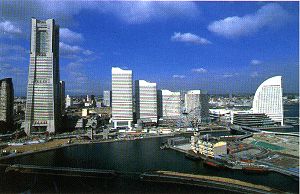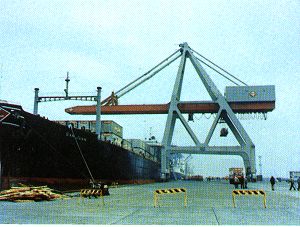- Yokohama-shi Top Page
- Sightseeing and events
- Port of Yokohama
- Experience Yokohama Port
- Learn Yokohama Port
- History of Yokohama Port
- Go to Minato! History of Yokohama Port (5)
Here's the text.
Go to Minato! History of Yokohama Port (5)
Last Updated July 31, 2024
![]() History of Yokohama Port (for the general public)
History of Yokohama Port (for the general public)![]() Opening of Port to Civilization
Opening of Port to Civilization ![]() Municipal organization enforcement-Great Kanto Earthquake
Municipal organization enforcement-Great Kanto Earthquake ![]() Great East Japan Earthquake Reconstruction: World War II
Great East Japan Earthquake Reconstruction: World War II![]() Post-war-high economic growth
Post-war-high economic growth![]() period container age-present
period container age-present
5.Container Age - Present
1974~
1974~

I hope Minato Mirai 21
The drastic change in the Japanese economy, such as high economic growth has become a wave of modernization and rationalization, and has had a major impact on ports.
From around 1967 (Showa 42), a large iron box called "containers" began to be used for transporting foreign cargo.
Until then, many cargoes were individually packaged and loaded on ships one by one, so packing ( loading and cargo handling for unloading transporting from the port to the port, etc., took a lot of time, money and money.
However, with the use of "containers", cargo packaging becomes easier cargo handling can be carried out in large quantities in a short time with a large crane called gantry crane, and cargo is organized by recipient. As a result, transportation from the port to the port was very fast and easier.
In addition, the transportation of cargo by container has become more secure.
The amount of container cargo continues to increase at a tremendous rate every year.
Containerships, which carry containers exclusively, have emerged, and the size of ships is increasing.
However, since all the facilities at Yokohama Port were built for general cargo ships from ancient times, these facilities could also serve as containers, but since the efficiency not good, port facilities for container ships had to be constructed in a hurry.
Therefore, in Yokohama City, a port plan was set up to handle container cargo, and first, a facility for container cargo was constructed by constructing Honmoku Wharf and Daikoku Wharf, and installing "Gantry Clane". (
However, in order to cope with the increasing number of container cargo, we started construction of Minamihonmoku Wharf in 1991 and opened two of our four container terminal plans in 2001, and in 2015, we opened a third terminal in 2015.
In this way, the port has been expanded to the offshore side due to the maintenance that began in the middle of the Meiji era but 150 years after the opening of the port, from Yamauchi Wharf and Takashima Wharf The Osanbashi area has become the deepest part of the port, and the deterioration progressed.
For this reason, the Minato Mirai 21 Plan and the Osanbashi Wharf Redevelopment Project, which harmonize the port and the town and create a new waterfront for Yokohama, were promoted. .
The Nippon Maru, Yokohama Minato Museum ( Akarengasoko, Rinko Park (Seaside Park), Zounohana Park, Marine Park, Hakkeijima Island, and sea fishing facilities are being developed and used to make the port accessible to citizens, including , which is indispensable to the port.

San Juan, First Ship of Full Contenna (Photo: Yokohama Minato Museum)
"Main Imports of this Age"

Nonferrous Metals

Car (Jidosha)
"Major exports of this era"

Office equipment (Jimyouukiki)

Car (Jidosha)
Inquiries to this page
Policy Coordination Division, Policy Coordination Division, Port and Harbor Bureau Policy Coordination Department
Telephone: 045-671-7165
Telephone: 045-671-7165
Fax: 045-671-7310
Email address: kw-seisaku@city.yokohama.lg.jp
Page ID: 657-601-370







